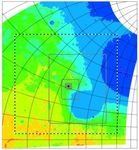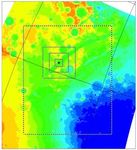METEOROLOGICAL PREDICTIONS FOR MARS2020 EXPLORATION ROVER HIGH-PRIORITY LANDING SITES
←
→
Page content transcription
If your browser does not render page correctly, please read the page content below
METEOROLOGICAL PREDICTIONS FOR MARS2020 EXPLORATION
ROVER HIGH-PRIORITY LANDING SITES
J. Pla-García, Centro de Astrobiología (CSIC-INTA), Madrid, Spain; Southwest Research Institute, Boulder
CO 80302; USA and Space Science Institute, Boulder CO 80301, USA (jpla@cab.inta-csic.es), Scot C.R.
Rafkin, Southwest Research Institute, Boulder CO 80302, Alberto G. Fairen, Centro de Astrobiología (CSIC-
INTA), Madrid, Spain; Dept. Astronomy, Cornell University, Ithaca NY 14853.
2.96km. The model is run for 5 sols. Initialization
Introduction: and boundary condition data are taken from a NASA
The Mars Regional Atmospheric Modeling Sys- Ames GCM simulation with column dust opacity
tem (MRAMS) is used to predict meteorological driven by zonally-averaged TES retrievals. Vertical
conditions that are likely to be encountered by the dust distribution is given by a Conrath- parameteri-
Mars 2020 Rover at several proposed landing sites zation that varies with season and latitude.
during entry, descent, and landing (EDL). The mete-
orology during the EDL window at most of the sites Water vapor cycle on Mawrth Valley:
is dynamic. The intense heating of the lower atmos- Atmospheric transport is the driving mechanism
phere drives intense thermals and mesoscale thermal in the absence of a local source for the water vapor
circulations. Moderate mean winds, wind shear, tur- cycle on Mars. The primary source of water vapor to
bulence, and vertical air currents associated with the atmosphere is the northern polar cap during the
convection are present and potentially hazardous to Spring and early Summer. Once the winter CO2 re-
EDL [1]. Eleven areas with specific high-priority treats, the underlying polar water ice is exposed and
landing ellipses of the 2020 Rover, are investigated: begins to sublimate. The water is transported
the eight high-priority remaining NE Syrtis, Nili equatorward where it is manifested in the tropical
Fossae, Jezero Crater Delta, Holden Crater, South- aphelion cloud belt. If transport is assumed to be the
west Melas Basin, Mawrth Vallis, , Columbia Hills result of the Hadley Cell, then the polar water is car-
and Eberswalde and the three of the recently rejected ried aloft in the northern high latitude rising branch
East Margaritifer Chloride, McLaughlin Crater and before moving equatorward and eventually toward
Nili Fossae Carbonates. MRAMS was applied to the the southern high latitudes [4, 5], see Figure 6. If this
landing site regions using nested grids with a spac- is the case, then the equatorial surface regions are
ing of ~3 km on the innermost grid that is centered moistened only once the water has moved to the
over each landing site (see example on Figure 1). southern hemisphere, descended to the surface, and
MRAMS is ideally suited for this investigation; the is then moved northward at the surface back toward
model is explicitly designed to simulate Mars’ at- the equator. At the same time, it is likely that transi-
mospheric thermal circulations at the mesoscale and ent waves (e.g., storm systems) as well as boundary
smaller with realistic, high-resolution surface prop- currents associated with planetary-scale stationary
erties [2, 3]. Atmospheric circulation (see example waves also advect and mix water equatorward.
on Figure 2) and vertical profiles of horizontal wind New numerical experiments are being performed
speeds, vertical wind speeds, and air temperature looking for evidence of a direct transport connection
(see examples on Figures 3, 4 and 5), are studied to of the Mars2020 Mawrth Vallis landing site to the
evaluate risks during EDL phase of the mission. For northern polar regions. Mawrth, an ancient water
some landing sites simulations, two example config- outflow channel with light-colored clay-rich rocks,
urations –including or not Hellas basin in the mother is in the mid-latitude north hemisphere (Oxia Palus
domain- were generated, in order to study how the quadrangle), and is the closest Mars2020 landing site
basin affects the innermost grids circulations. After- to north polar cap. We are studying if moist air in
noon circulations at all sites pose some risk for en- northern spring/summer makes it to Mawrth at Ls90
try, descent, and landing. Most of the atmospheric and Ls180, two periods with high column abundance
hazards are not evident in current observational data of water vapor at mid/high latitudes [6], see figure 7.
or general circulation model simulations and can The objective is to study if circulation (mean or re-
only be ascertained through mesoscale modeling of gional) is favorable for transport water vapor from
the region. Deciding where to go first and then de- north polar cap to Mawrth Vallis to activate hygro-
signing a system that can tolerate the environment scopic salts and/or chlorides. If affirmative, it should
would greatly minimize risk. be a go-to site due to habitability implications.
MRAMS was not run with an active water cycle
Methodology: although it has that capability. Future simulations
The simulation is configured with 5 grids. The with an active water cycle will help to better quanti-
innermost grid has a horizontal grid spacing of fy the fate of water.2016.
[6] Jakosky, B.M., and C.B. Farmer, The season-
Conclusions: al and global behavior of water vapor in the Mars
Most of the atmospheric hazards are not evident atmosphere: complete global results of the Viking
in current observational data or general circulation Atmospheric Water Detector experiment, J.
model simulations and can be only be ascertained Geophys. Res., 87, 2999-3019, 1982.
through mesoscale modeling of the region, providing
estimates of the atmospheric hazards at potential
landing sites. GCM models are important for identi-
fying regions where synoptic-scale circulations and
winds are favorable.
The meteorology during the EDL window at
most of the sites is dynamic. Moderate mean winds,
wind shear and vertical air currents associated with
convection are present and potentially hazardous to
EDL.
Afternoon circulations at all sites may pose
some risk to entry, descent and landing. Vertical Figure 1: Horizontal Grid Spacing applied to Nili
shear of the horizontal wind can induce unwanted Fossae landing site.
oscillations of the EDL system.
Vertical variations of the vertical wind can also
be hazardous.
If moist air in northern spring/summer makes it
to Mawrth Vallis at Ls90 and Ls180 and feed hygro-
scopic salts and/or chlorides, it should be a go-to site
due to habitability implications.
Aknowledgements:
The work of J.P.-G. was supported by the Spa-
nishMinistry of Economy and Competitiveness un-
der contracts AYA2011-25720 and AYA2012-
38707. The work of S.R. was supported by a contra-
ct under the Mars Critic Data Program. The work of
A.G.F. was supported by the Project “icyMARS”,
European Research Council Starting Grant no Figure 2: Atmospheric circulation of Nili Fossae
307496. landing site.
References:
[1] Rafkin, S. C. R. and T. I. Michaels, 2003:
Meterological predictions for 2003 Mars Exploration
Rover high-priority landing sites. J. Geophys. Res,
108 No. E12, 8091
[2] Rafkin, S. C. R., Haberle, R. M., and T. I.
Michaels, 2001: The Mars Regional Atmospheric
Modeling System (MRAMS): Model description and
selected simulations. Icarus, 151, 228-256.
[3] Rafkin, S. C. R., M. R. V. Sta. Maria, and T.
I. Michaels, 2002: Simulation of the atmospheric
thermal circulation of a martian volcano using a
mesoscale numerical model. Nature, 419, 697-699.
[4] Jorge Pla-García, Scot Rafkin et al.:“The Me-
teorology of Gale Crater as Determined from Rover Figure 3: Horizontal wind speed vertical profile of
Environmental Monitoring Station Observations and Nili Fossae landing site.
Numerical Modeling. Part I: Comparison of Model
Simulations with Observations”. Icarus, 2016.
[5] Scot Rafkin, Jorge Pla-García et al.:“The Me-
teorology of Gale Crater as Determined from Rover
Environmental Monitoring Station Observations and
Numerical Modeling. Part II: Interpretation”. Icarus,of temperature sets up a large-scale pressure gradient
that drives a meridional circulation.
Figure 4: Vertical wind speed vertical profile of Nili
Fossae landing site.
Figure 7: The column abundance of water vapor as
a function of Ls and latitude: (top) as observed by
TES. Contours show a smoothed representation of
the results, and (bottom) as observed by Viking
MAWD [Jakosky and Farmer, 1982].
Figure 5: Air temperature vertical profile of Nili
Fossae landing site.
Figure 6: The seasonal planetary latitudinal gradientYou can also read






















































